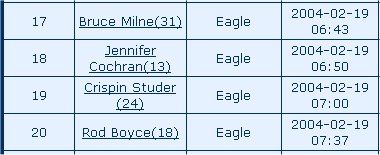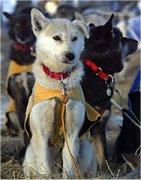February 19, 2004
HEY ROD

If it's February in Alaska, it must be time for my friend Rod Boyce to do something crazy in the snow.
Four years ago, Rod decided to test his newfound dog mushing skills by entering the Tustumena 200 sled dog race on the Kenai Peninsula.
Problem was, he picked a year with one of the worst storms in the Kenai's history and he got lost. Six days later, rescuers finally found him. He was down to his last Reese's piece. You can read the entire account here. I highly recommend it. It's gripping stuff.
Anyway, Rod's back at it. He's taking time off as news editor at The Fairbanks Daily News-Miner to run in this year's Yukon Quest, a 1,000 mile race from Fairbanks to Whitehorse, Canada.
A lot of mushers use the Quest to train for the Iditarod Trail Sled Dog Race. What many find out is that although is a longer race in terms of distance, it's a slice of heaven compared to the Quest, which Alaskans consider a real test of skill since there is so little race support compared to the Iditarod.
Rod's doing a great job this year. He's in 20th place at the moment, out of 31 mushers. Eight of those 31 have scratched from the race.

You can tell by the race standings that he and the three mushers above him are all traveling together - there's only about 45 minutes separating him from the No. 17 musher. And he's only dropped 2 dogs from his team, which means that everyone in the pack is healthy.
But weather is always an issue.
In fact, according to The Whitehorse Star, one musher who was having trouble decided to scratch instead of continue because the temperatures were dropping and he didn't want to push a point.
The musher was helped to the checkpoint by another musher. Normally this is forbidden in a race unless there are life-and-death circumstances, but the race marshall made a decision not to disqualify the good samaritan musher since the temperatures were so cold.
The race marshal didnít have an exact temperature on the trail though to make his determination.
"My truck thermometer said -40 F and itís been logged there all night and other people had -50 F, and I figure down there in the creek, they were looking at 55 to 60 below.''

Unlike the Iditarod, which finishes underneath an arch of burled wood, the Quest finish line is a small motorhome parked to one side, two powerpoles with the banner stretched between them, some wooden road barricades to hold back the spectators, and three or four sets of portable bleachers so those in the back can see over those at the front.
Inside the motorhome can be found volunteers who take holidays or leave-without-pay from work to satisfy their own fascination with dog mushing. They sleep, eat and wait patiently in shifts, 24 hours a day, watching the river for approaching teams. They move into the vehicle a day or so before the first musher arrives and won't leave the area unstaffed until the last one is safely across the line. It can be minutes, hours or even days between teams.
Because of the uncertainty of predicting the exact times of arrival, crowds at the finish line tend to be small. A few minutes after each musher crosses the finish line, the crowd size almost doubles as news of a new arrival is spread.
When a musher does roll in, the crowds see some unusual things.
In 1986, former Iditarod champ Joe May finished his 12-year racing career with a camp fire in the Quest's finishing chute. With a tear freezing on his eyelash, he announced his retirement by placing his snowshoes on top of the fire and watching as the flames consumed them.
Ron Aldrich was greeted by a woman standing in the snow wearing a yellow polka-dot bikini. It was minus 20 degrees when Aldrich finished in 1984 and his wife wore a warm overcoat that she opened to flash her garb at him at the appropriate moment. A lot of the bystanders never knew who she was or what she wore, if anything. All they could see were her bare legs under a long coat.
Lorrina Mitchell was the first woman to ride to the finish line in that first Quest in 1984. Only a few spectators were on hand to greet her, but the one she remembers best was sitting across the river from the finish line.
"It was a cat and, you know, the dogs didn't even look at it. They couldn't care less. They could see the finish line across the river. This cat was sitting on the riverbank just terrified, staring at us, but we went right on by."